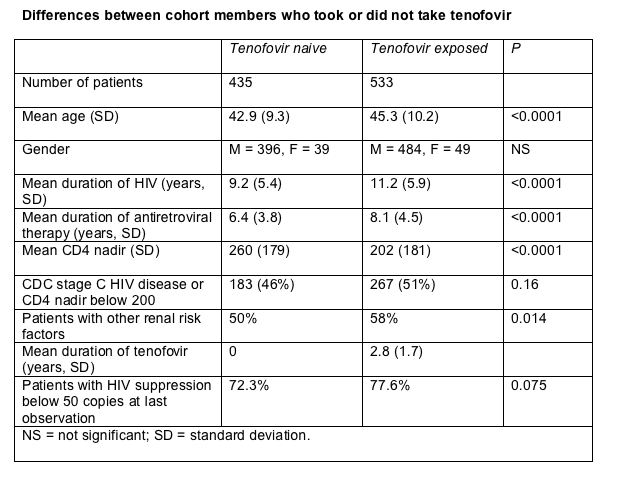 |
 |
 |
| |
Risk Factors for Kidney Complications
|
| |
| |
11th European AIDS Conference
October 24-27, 2007
Madrid
Mark Mascolini
A thousand-patient single-center study from Germany figured a higher risk of "clinically significant" renal toxicity among people who took tenofovir than in those who did not [1]. But the authors also found plenty of other renal risk factors in people taking this potent reverse transcriptase inhibitor.
This retrospective analysis involved 533 people who took tenofovir at some point and 435 who never tried the drug. The tenofovir group had several disadvantages that may well have raised their risk of kidney complications (Table). A significantly higher proportion of tenofovir takers had other renal risk factors, they had more advanced HIV infection, they had more antiretroviral experience, and they were older. A higher proportion of people taking tenofovir also reached an undetectable viral load, though this difference from the no-tenofovir group stopped short of statistical significance (Table).

Knud Schewe and colleagues from Infektionsmedizinisches Centrum Hamburg St. Georg defined clinically significant renal toxicity as a creatinine jump of at least 0.5 mg/dL after starting or while taking tenofovir or stopping tenofovir because of kidney toxicity. For the control group they defined clinically significant renal toxicity as the same rise in creatinine on a single occasion during antiretroviral therapy compared with the last pretherapy creatinine or the first available creatinine on therapy.
Twenty-six people taking tenofovir (5%) and 23 not taking tenofovir (6%) had at least a 0.5-mg creatinine climb. When Schewe adjusted those rates for patient-years of treatment, elevated creatinine incidence proved significantly higher in the tenofovir group (1.8 versus 0.9 cases per 100 patient-years, P < 0.012). But in logistic regression analysis factoring in age, antiretroviral duration, CD4 nadir, CDC disease stage, and other renal risk factors, the heightened kidney risk with tenofovir lost statistical significance (P = 0.062), perhaps, the authors suggested, because of the small number of cases involved.
When the researchers looked at all 31 tenofovir takers who met their definition of clinically significant renal toxicity (5.9%), they figured an incidence of 2.1 cases per 100 patient-years. These people averaged 55.6 years in age, had HIV infection for an average 13.2 years, had taken antiretrovirals for an average 9.7 years, and had taken tenofovir for an average 3.2 years. Twenty-four of these 31 (77%) had CDC stage C disease or a CD4 nadir under 200, 26 (84%) took a ritonavir-boosted protease inhibitor with tenofovir, 25 (81%) had at least one other renal risk factor (another nephrotoxic medication or hypertension, diabetes, or cardiovascular disease), 7 (23%) had renal disease before starting tenofovir, and 8 (26%) had chronic hepatitis B or C. At their last follow-up visit, 24 of these people (77%) had an HIV load under 50 copies.
Signs of renal trouble in the 31 people with clinically significant kidney toxicity while taking tenofovir included a creatinine rise of at least 0.5 mg/dL in 26 (84%), proteinuria in 15 of 24 tested (63%), glucosuria in 7 of 24 (29%), and hypophosphatemia in 5 of 24 (21%). No one had Fanconi syndrome.
Schewe and coworkers found proteinuria and glucosuria (with a normal serum glucose) the strongest predictors of renal problems during tenofovir therapy. Five people who had urinary abnormalities pointing to renal tubular damage did not have a creatinine rise of 0.5 mg/dL, a finding the researchers believe "underscores the importance of regular urine examinations" in people taking tenofovir.
Of the 31 people with clinically significant renal toxicity during tenofovir therapy, 10 stopped the drug; 6 of them regained pre-tenofovir kidney function during follow-up and 4 had partially improved renal function. Of the 21 people who continued tenofovir, 11 regained pre-tenofovir renal function, 5 had partial improvement, 3 had no improvement, and 2 endured worsening renal function marked by chronic glomerulonephritis. Five of the 11 people who continued tenofovir dropped back to a lower dose.
Reference
1. Schewe K, Christ H, Adam A, et al. Incidence of clinically significant renal events among patients treated with tenofovir (TDF) in comparison to patients who never received TDF as part of their ART: results of an observational cohort study. 11th European AIDS Conference. October 24-27, 2007. Madrid. Abstract P9.1/03.
|
| |
|
 |
 |
|
|